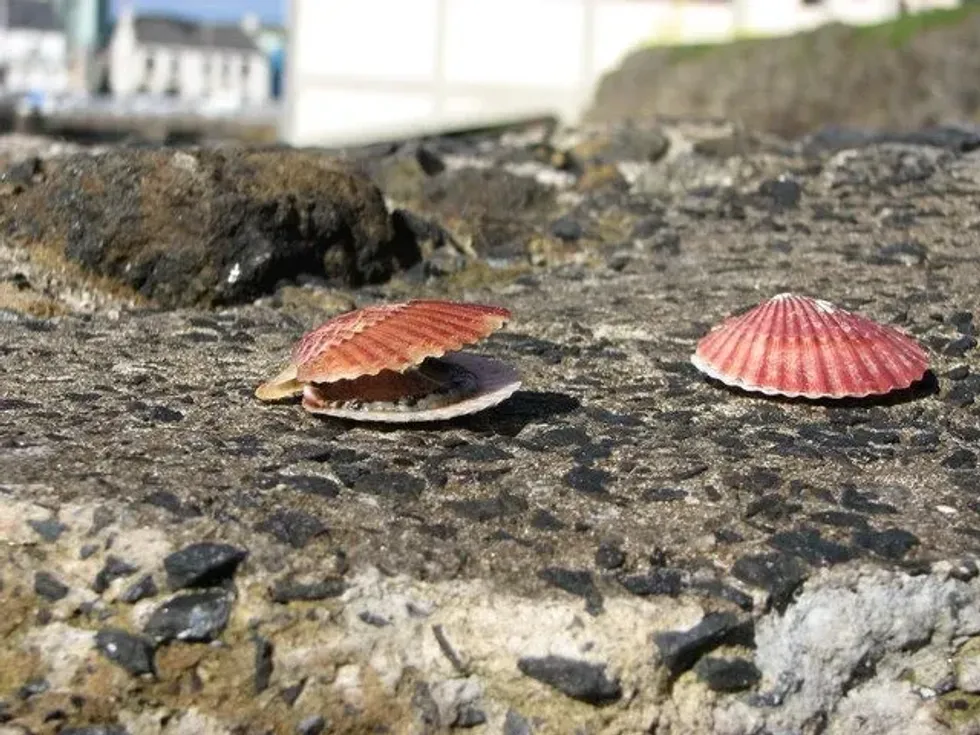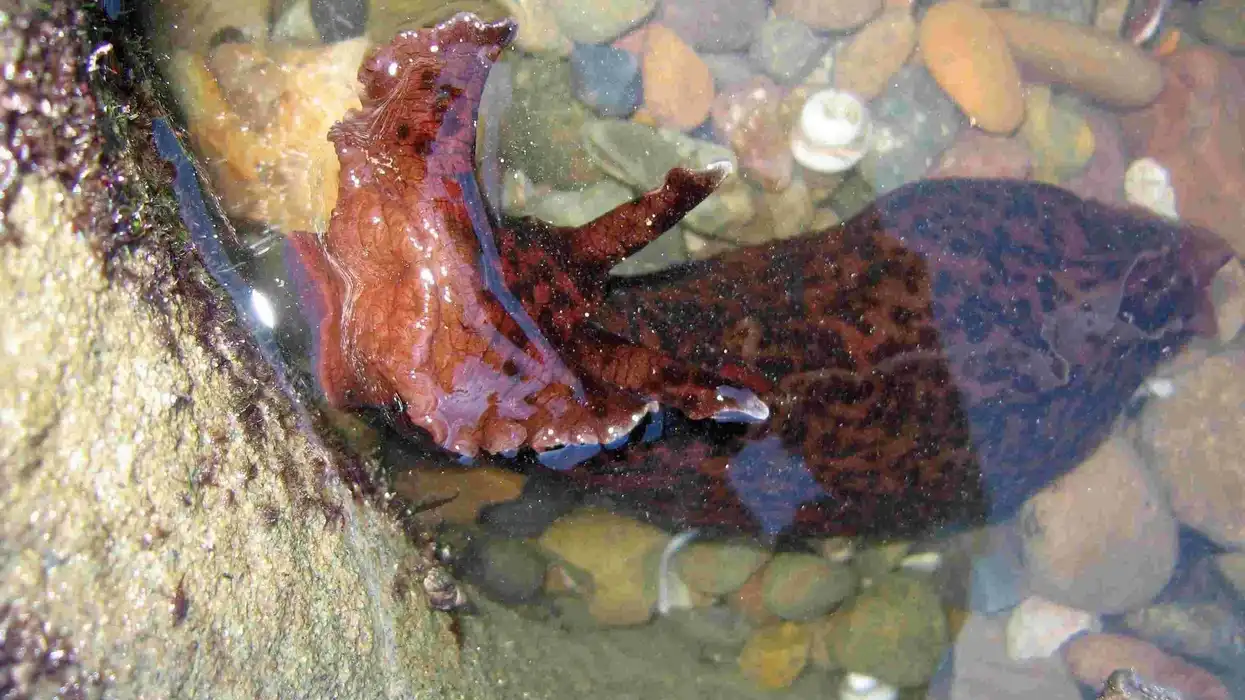Scallops constitute a large number of species who are marine bivalves mollusks or saltwater clams. These mollusks and clams belong to the taxonomic family Pectinidae. Mollusks and clams are very similar. The word 'scallop' is also associated with other closely related species like thorny oysters. Atlantic sea scallops are found in the northwest Atlantic Ocean.
Scallops (mollusks and clams) are bivalves of a cosmopolitan kind of family found in all global ocean floors, but not in fresh water. They are free-living bivalves and this species is capable of swimming short distances and migrating to distances across the floor of oceans.
A small percentage of scallop species can be found living along rocky substrates after adulthood. Other scallops can be found glued to rooted or stationary objects such as grasses by the byssal thread.
A major number of species live on sandy substrates and on sensing predators like starfish, they make an attempt to escape by swimming erratically using jet propulsion by clapping their shells.
Scallops are known to have a fully developed nervous system. These bivalves are unique as they have a ring of several simple eyes around the edge of mantles.
Scallops are known as a sought after seafood source, and some are farmed as aquaculture. The meat of these bivalves, i.e. the adductor muscle, are also called scallops.
They are sold as seafood. The shells of scallops are attractive and of various shapes. A scallop shell is used for ornamentation and also used as motifs in architecture, design, and art.
Scallop shells are a frequent sight on beaches. These brightly colored objects are collectibles for vacationers and beachcombers. Creating a scallop shell collection has become a hobby for many.
For more relatable content, check out these oyster facts and mussel facts for kids.
Scallop Interesting Facts
What type of animal is a scallop?
A sea scallop is a type of bivalve shellfish that lives on shallow sea beds.
What class of animal does a scallop belong to?
Scallops belong to the class of arthropods and the family Pectinidae.
How many scallops are there in the world?
The estimated population of scallops (family Pectinidae) in the world is between 25-45 billion.
Where does a scallop live?
A scallop animal (family Pectinidae) is an aquatic shellfish that lives in the ocean.
What is a scallop's habitat?
All oceans of the world form the scallop habitat. The majority of scallops (family Pectinidae) are found in the Indo-Pacific Ocean on the ocean floor. Most scallops prefer shallow water or they attach themselves to coral.
Who do scallops live with?
We cannot say if scallops live alone or in groups.
How long does a scallop live?
A scallop can have a lifespan of up to 20 years. Some varieties like the Atlantic sea scallop have shorter lifespans. The age of a scallop can be found out by counting the annuli or rings on their shells.
How do they reproduce?
Scallops can be dioecious (both males and females separately), or hermaphrodites (male and female sexes in one scallop). Few scallops are protandrous hermaphrodites, meaning they are male when young then changing to female.
Scallops reproduce by the spawning method. When the males release sperms into the water, there are absorbed by the female. Among hermaphrodites these roles may change or they may release both eggs and sperm.
The ideal breeding season for scallops is summer or spring, between the months of March and June. Scallops reproduce sexually as well as asexually through spawning.
The reproductive part of the scallop is called coral or roe, and the female scallop’s genitals turn pink in the breeding seasons. Male scallops are white. Females can lay millions of eggs in a cluster but only few survive. Baby scallops in larval state are called veligers.
After birth, baby scallops feed on plankton and settle on the sea bed through byssal threads.
What is their conservation status?
Scallops have a status of Least Concern.
Scallop Fun Facts
What do scallops look like?
Scallops are bivalve shellfish that range between dull creamy colors to very vivid hues. They have hinged valves or shells, blue eyes, single adductor muscles more advanced than those of mussels, clams and oysters. Their mouths or openings are surrounded by cilia. These cilia allow passage of food and feces.
The blue scallop eyes are the main source of interaction with the environment. Scallop eyes can be up to 200 in number. Unlike other bivalves like clams and oysters, scallops lack a siphon.
How cute are they?
Sea scallops do not look cute. They have hard outer bivalves and rarely resemble any animal.
How do they communicate?
Scallops are an underwater bivalve species that do not have brains. However, they are good at sensing predators and have survival instincts. They interact with the sea environment for food, excretion, and sensing predators.
A scallop can make coughing sounds while expelling feces or water from its body. Their highly receptive blue eyes are the main source of communication. Singing scallops are a type of sea scallop that make popping sounds when flapping their valves or shells underwater.
How big is a scallop?
Bay scallops measure up to 4 in (10.16 cm) while sea scallops such as the Atlantic sea scallops are about 9-10 in (22.86-25.4 cm) in size. Facts say that these bivalve species are at least two times larger than the prawn, a crustacean which is 1-2 in (2.5-5 cm) in size.
Can scallops move?
Most species of bivalves are slow in locomotion, however scallops move freely and actively through the sea. Scallops have a byssus in the beginning of their lives, however they lose it when they grow up.
Some species go for cementation to hard substrates. Scallops are mostly free-living and can move with great bursts if they need to escape predators.
For such a movement, they open and close their valves rapidly. To move with such quick bursts, their body has several modifications such as a small flexible hinge, symmetry, powerful adductor muscle, and narrowness.
How much does a scallop weigh?
Bay scallops can weigh between 0.01-0.02 oz (0.35-0.52 g). Larger sea scallops can weigh about 3.52 oz (100 g) or more.
What are male and female names of the species?
Male and female scallops are both called by the same name.
What would you call a baby scallop?
A baby sea scallop or larval scallop is called a veliger.
What do they eat?
The scallop diet includes planktons, algae, and krills. They are known to be filter feeders which trap food in their mucus.
Are they harmful?
Researchers have found heavy metals like cadmium, lead, and mercury in scallops. Although they are not in high concentrations to be considered very dangerous for humans, their high amounts may lead to cancer-like health problems.
Would they make a good pet?
Scallops are beautiful and peaceful. They are great add-ons to your aquarium tank. However, they need to be tenderly taken care of.
Did you know…
The age of scallops can be determined by counting their annuli on their shells.
The blue eyes of a scallop have photoreceptors, and they can regenerate. Scallop eyes are highly sensitive.
Scallops do not have brains, just nervous systems.
Scallops have had symbolic value since ancient times.
Mussels, clams, oysters are other varieties of bivalves.
Live scallops are eaten as seafood, and are considered more delicious than cooked or seared scallops. Scallops are a seafood delicacy and a source of many nutrients. Some scallop recipes include pan seared scallops, smoked scallops, and scallop stew.
Scallop season is conducted each year in Florida for recreational scalloping.
Do scallops have eyes?
Yes, scallops have a lot of eyes, around 200 in number. These small eyes are arranged along their mantle edge.
They have so many eyes because they rely on them to detect threats from predators in the wild. These eyes act as early warning signals and are imperative for their survival. They scanobjects around them in the wild for shadows and movements.
How to eat scallops?
Scallops have a mild taste which can easily absorb different flavors. If properly cooked, they acquire a delicate, slightly sweet, and buttery flavor.
Scallops have a rich and light taste and are succulent. The part of a scallop which is most delicious when eaten is the adductor muscle. Scallops are expensive due to the high demand for them matched by low supply.
For cooking scallop recipes you may follow the following steps:
Avoid any moisture in the live scallop. Blot them with a paper towel to reduce the moisture further. Sprinkle salt on the towel and keep it there for a few minutes. The most essential key is to have negligible moisture before the scallops touch the pan.
The scallops then have to be cooked to a high temperature and very fast on the pan. The pan should be preheated well. Put some oil at the high smoke point. After the scallop has cooked, apply some butter for flavor.
There are many scallop recipes and they can be cooked through various methods like baking, saute, and roasting. The most common is the seared scallop. Cook scallops using various methods and cherish the variety it provides. Cooking scallops is an enjoyment worth cherishing and the recipes have a wonderful taste.
Here at Kidadl, we have carefully created lots of interesting family-friendly animal facts for everyone to discover! Learn more about some other arthropods from our freshwater mussels facts and giant clam facts pages.
You can even occupy yourself at home by drawing one on our [scallop shell] coloring pages. You can even occupy yourself at home by coloring in one of our scallop shell coloring pages.









